01dragonslayer
Ripped
- Jacked Cash
- 472,456
Looking for the most comprehensive muscle building guide on the internet? Well, good thing you stopped by, I’ve got you covered.
This guide will take you through everything from nutrition to training and even supplementation, which will get you on the right path to add quality slabs of muscle.
If you need help or clarification, please feel free to post a question or comment at the end of this guide.
When someone lifts weights, they create trauma within the muscle fiber by generating micro-tears. Once damage occurs, a cascade of biochemical signaling takes place and satellite cells become active. These cells actually bind to muscle cells in order to repair the damaged areas and help to synthesize new contractile components.
When these components increase in cross-sectional area, you experience the phenomenon commonly known as muscular hypertrophy.
Essentially, you must remember the goal of training is to stimulate protein synthesis but the key to building muscle is cellular repair, not damage.
Now don't get me wrong, there is some truth to the saying, "stimulate, don't annihilate." But, to quote supergenius and performance specialist Alex Viada,
"Adaptation requires pushing the body to do something it doesn't really want to do, it's gonna hurt. If it gets easier, then chances are, you're getting lazier."
Before we get into breaking down each somatotype, let’s first examine the origins and significance of body typing.
Somatotypes were originally developed by a psychologist from Rhode Island named William Herbert Sheldon. Originally, body typing was developed to characterize an individual’s psychological state based upon their anthropometry.
In the end, the bodybuilding and fitness community adapted the somatotype classification system as a way to categorize physical deviations present in trainees.
Not only that, the original model developed by Sheldon was designed entirely for men, so what are women supposed to use?
As you can see, somatotypes are fairly limited in their design, application, and significance. That being said though, here are so typical characteristics exhibited by each classification within Sheldon’s developmental model:
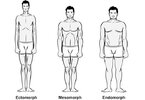
Image courtesy of Govt. of Western Aust. Dept. of Health

If you’ll notice, I didn’t include any specifics on training or nutrition recommendations for each body type like most articles.
In fact, I think that most of those articles are rather short-sighted in their approach as many folks don’t follow the “cookie-cutter” outline associated with somatotypes.
For example, what happens if you possess an ectomorphic build but you feel terrible on a higher carb diet and you can handle 5 days of training per week?
Should you just continue to bang your head against the wall by slamming carbs, avoiding cardio, and only training 3 times per week because that’s what all the internet “experts” recommend?
In short, no.
Somatotypes were never designed as a means to estimate muscle growth potential or an individual’s genetic response to training.
Remember, body types are not the “be all, end all”; you’re not destined for hardgainer hell simply because you’re tall and lanky with narrow shoulders.
Similarly, you’re not doomed to put on fat if you’re an endomorph who loves carbs. This is merely a reference point, nothing more, nothing less.
Don’t limit yourself psychologically by believing your somatotype is something you can’t control and the limiting factor for your gains.
As Alexander Juan Antonio Cortes has said before,
“More than anything else, I think somatotypes are useful for the most general of classifications for beginning trainees, not as a rationale to limit one's potential. Your somatotype isn’t even “real.” Don’t use somatotypes as an excuse to create a preconceived limit where there isn’t one.”
After you establish your BMR, you'll need to use the active factor multiplier to calculate your total daily energy expenditure (TDEE). This is a combination of the calories need to maintain your basal metabolic rate coupled with your daily activities.
A lean bulk is generally recommended for healthy individuals at an average weight. Use the following formula to determine your daily calorie needs for a lean bulk:
TDEE + 250 calories.
Aggressive Bulk
If you’re fairly new to training, underweight, or a classic hardgainer, it might be beneficial to eat more aggressively. Use the following formula to determine your daily calorie needs for an aggressive bulk:
TDEE + 500 calories.
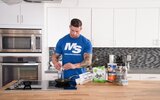
Keep in mind, all of these calculations are based upon algorithms for most individuals. However, they cannot factor in every individual variable such as NEAT (non-exercise activity thermogenesis), genotypes, hormones, lifestyle factors, hobbies, or nervous system dominance.
Therefore, some individuals may need to add more calories in order to gain weight while others will need less to get the scale moving in the right direction. Start with a set number, eat accordingly for a month, check the scale, and then reassess.
Realistically, if you’ve been training for a year or two, you should shoot for roughly 0.5 pounds per week. Beginners should aim slightly higher in the 0.75-1.0lb per week range in order to maximize their muscular potential.
Joe is a 20 years old student who is new to weight training but wants to gain some muscle. He’s 150lbs, 6 feet tall, and works part-time as a busboy at a local restaurant. He’s looking to train 4 days per week as he’s fairly skinny and resembles the average ectomorphic physique.
We’ll use Joe as a practical example to take you through the steps to determine your calories and macros. In step 1 you learned how to calculate base calories, now here’s how to break this all down into macros and plan your meals.
Now, don’t freak out, I know that may sound like a huge amount of carbs and/or calories but for some guys (and gals) this is what it’s going to take to build muscle.
As I mentioned above regarding carbs, if Joe can’t get that many carbs down or they don’t seem to sit well with him, then he could easily up his fats as they are calorically dense and low in volume.
I should also note that all of these recommendations are for young, healthy, and active individuals. Certain macronutrients would require manipulation in older populations and those who might not respond to specific nutrition strategies.

You don’t have to eat this exact meal plan, there is nothing magical about the foods included or any foods for that matter. This was merely an example to show you how you can easily set up your macros for your body and then compose a sound meal plan around them.
DAILY TOTAL: 3230 calories - 490g C/70g F/160g P
DAILY GOAL: 3250 calories - 505g C/70g F/150g P
Now, these totals don’t match exactly but they are close enough that the minutia won’t make a single difference. Consistency and sustainability determine success, not your ability to hit macros exactly.
That being said though, here are a few simple guidelines from the folks at Precision Nutrition for measuring your food intake if you don’t have access or don’t prefer to use a food scale:
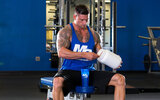
Calories are the building blocks of muscle but you should also be aware of each individual macronutrient and have a general idea of how much you’re consuming.
When it comes to making gains, you should do your best to keep things simple and wholesome on the nutrition side of the equation.
Stick primarily to whole foods, meaning foods that have one ingredient – the food itself and very minimal additives. Here are a few suggestions to get you started:
Once dietary macro and micronutrients have been met, some processed sources can be consumed to help increase caloric intake if appetite is lacking.
Hard training individuals can consume a higher level of "discretionary calories" from processed sources due to their high work output, but ideally, this should only compose 10-15% of their calorie intake. Remember, everything in moderation.
Until you nail both of those aspects, you won’t be able to “out supplement” poor lifestyle choices and you’re decision to neglect the two most influential components in your muscular development and physical growth.
As Paul Carter says,
"If your supplements cost more than your groceries, you've already failed."


If you’re the adventurous and inquisitive type, you might be interested in setting up your own workout routine but this takes a bit of experimentation and knowledge. Depending upon your preferences, goals, and availability, your training will likely revolve around one of the following training splits:
Remember, it’s not about getting fancy, it’s about a relentless application of the basics until you become a master in the most mundane things.
Ideally, you’d start your training session with foam rolling for 5 minutes and then move into a few dynamic stretches and activation drills for your shoulders and hips. It doesn’t have to be anything incredibly lengthy, but it will make a drastic difference if you incorporate these elements in the long run.
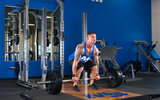
You can’t continually grind yourself to powder in the gym and expect your body to perform at 100% on the daily. As I said in the opening paragraph, “The key to building muscle is cellular repair, not damage.”
When you watch bodybuilders or professional athletes absolutely crushing volume, you have to remember that there are specific parameters in place that will allow them to train extremely hard and recover exceedingly well, namely performance-enhancing substances.
Steroid discussion aside, their lifestyle revolves around their training; they eat, train, eat, nap, eat, rest, eat, sleep, and then do it all over again. External stressors are limited in order to allow them to focus all of their time and energy on training and improving their physique or skill set.
For the average trainee, you should be focused upon these 3 points:
Most trainees should be shooting for 8 hours or more every night. Suffice it to say, you should be able to wake naturally at the same time every day without the use of an alarm clock. If not, you need to improve your sleep hygiene and circadian rhythms.
If you’re looking for some simple tips to maximize your Z’s when you’re in between the sheets, then check out this article I wrote on the subject: Hacking Your Sleep 101: Nine Tips For Better Gains.

Spend 5-10 minutes each day in complete silence, unplugged from social media or electronics. You’ll be surprised just how difficult this can be but it’s important to get away from the constant stress of updates, texts, and incessant messages.
Surround yourself with those who have similar goals in mind and are willing to build you up in your pursuits. If someone is constantly dragging you down, it’s going to wear on your motivation and desire to train.
Most muscles can sufficiently recover in roughly 48 hours so working them every other day is a good place to start, hence why most beginner total body programs are based on a 1 day on, 1 day off setup.
That's not to say you should never work muscle groups on back to back days as there are programs that do exactly that (e.g. Smolov, Sheiko, etc.), and folks have tremendous results. However, 48 hours is a solid general rule of thumb.
Not only that, your whole body needs time to adapt to the stimulus of lifting, you shouldn't expect to look like Arnold after 6 months in the gym.
Training through minor soreness is fine, but if you’re consistently lifting to the point where you can barely walk or psyching yourself up before every set, then it’s time to chill out and take a step back for your body’s sake.
Here are some popular 3-day splits which work exceptionally well:
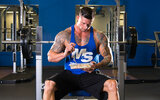
Morning:
That being said though, you’ll find that the vast majority of your success will come through preparation and staying consistent.
Sure, you’re going to eat a few meals at restaurants occasionally as there are social and celebrative aspects of food that should not be ignored or forgotten.
However, if you prep and cook most of your meals, you’ll find that it is much easier to maintain a healthy lifestyle when nutritious options are readily available. This process doesn’t start in your kitchen though, it begins when you walk into the grocery store.
If you only have healthy options available at your house, then it will be much easier to make a conscious effort to eat whole, nutritious foods. Food prep will take a little time out of your schedule in order to make sure you’re ready for the week but in the end, it will make your life easier during the hectic periods.

You don’t have to document every single occurrence in your fitness journey but some may enjoy the process and find satisfaction in the little things. Progress pictures and measurements are an easy way to objectively measure progress rather than just relying upon your subjective opinion, what you see in the mirror, and the scale.
Above all else though, make sure that you’re keeping track of your nutrition and training. You should be focused upon progressive overload in each training session and you should also have a general idea of how many calories you’re consuming.
I’ve already laid out 2 different methods for calorie tracking above so whichever you choose, just make sure you’re consistent so that you can make adjustments when progress stalls.
However, for some folks, motivation seems to wane with every passing day as they fight to sleep in and skip workouts or blow off their diet when things get tough.
In the midst of this social media obsession, it can be quite tough to find the motivation to work out when so many shirtless selfies are posted to demonstrate the progress of certain individuals.
We have to remember that psychological factors play a huge role in intrinsic motivation and the commitment to remain dedicated despite the influence of external factors.
For example, intrinsic motivation stems from behaviors that are personally rewarding whereas extrinsic motivation is rooted in behaviors based on the enticement of reward or to avoid punishment.
When it comes to your goals, individuals with high intrinsic motivation often reach their goals and remain successful as they are motivated by the enjoyment of the activity rather than the need to feel social validation from their physique.
As such, you’d be better off having a qualified professional perform your caliper assessment or stick to just strictly overall girth measurements coupled with the scale and the mirror to determine your current state of progress.
Remember, it’s about progress, not perfection.
This guide will take you through everything from nutrition to training and even supplementation, which will get you on the right path to add quality slabs of muscle.
If you need help or clarification, please feel free to post a question or comment at the end of this guide.
How Do You Actually Build Muscle?
Before we discuss the nuts and bolts of how to build muscle, we need to run through the basics of muscle physiology so that we’re all on the same page.When someone lifts weights, they create trauma within the muscle fiber by generating micro-tears. Once damage occurs, a cascade of biochemical signaling takes place and satellite cells become active. These cells actually bind to muscle cells in order to repair the damaged areas and help to synthesize new contractile components.
When these components increase in cross-sectional area, you experience the phenomenon commonly known as muscular hypertrophy.
Essentially, you must remember the goal of training is to stimulate protein synthesis but the key to building muscle is cellular repair, not damage.
Now don't get me wrong, there is some truth to the saying, "stimulate, don't annihilate." But, to quote supergenius and performance specialist Alex Viada,
"Adaptation requires pushing the body to do something it doesn't really want to do, it's gonna hurt. If it gets easier, then chances are, you're getting lazier."
Somatotypes: Do They Even Matter?
When it comes to training and nutrition, most guys want to classify themselves in 1 of 3 body type categories: ectomorph, mesomorph, or endomorph.Before we get into breaking down each somatotype, let’s first examine the origins and significance of body typing.
Somatotypes were originally developed by a psychologist from Rhode Island named William Herbert Sheldon. Originally, body typing was developed to characterize an individual’s psychological state based upon their anthropometry.
In the end, the bodybuilding and fitness community adapted the somatotype classification system as a way to categorize physical deviations present in trainees.
Not only that, the original model developed by Sheldon was designed entirely for men, so what are women supposed to use?
As you can see, somatotypes are fairly limited in their design, application, and significance. That being said though, here are so typical characteristics exhibited by each classification within Sheldon’s developmental model:

Image courtesy of Govt. of Western Aust. Dept. of Health
Ectomorph
- Typical skinny guy:
- Small joints
- Narrow shoulders
- Fairly lean build
- Long bone structure
- Tall and lanky
- Defined as a “hardgainer” in the weight training community
Mesomorph
- Fairly athletic physique:
- Large bone structure
- Higher levels of lean body mass
- Somewhat “blocky” appearance
- Naturally strong despite a lack of proper training
Endomorph
- Short and “stocky” physique:
- Thick overall
- Slightly higher levels of body fat
- Limb lengths provide advantages to strength training in the lower body

If you’ll notice, I didn’t include any specifics on training or nutrition recommendations for each body type like most articles.
In fact, I think that most of those articles are rather short-sighted in their approach as many folks don’t follow the “cookie-cutter” outline associated with somatotypes.
For example, what happens if you possess an ectomorphic build but you feel terrible on a higher carb diet and you can handle 5 days of training per week?
Should you just continue to bang your head against the wall by slamming carbs, avoiding cardio, and only training 3 times per week because that’s what all the internet “experts” recommend?
In short, no.
Somatotypes were never designed as a means to estimate muscle growth potential or an individual’s genetic response to training.
Remember, body types are not the “be all, end all”; you’re not destined for hardgainer hell simply because you’re tall and lanky with narrow shoulders.
Similarly, you’re not doomed to put on fat if you’re an endomorph who loves carbs. This is merely a reference point, nothing more, nothing less.
Don’t limit yourself psychologically by believing your somatotype is something you can’t control and the limiting factor for your gains.
As Alexander Juan Antonio Cortes has said before,
“More than anything else, I think somatotypes are useful for the most general of classifications for beginning trainees, not as a rationale to limit one's potential. Your somatotype isn’t even “real.” Don’t use somatotypes as an excuse to create a preconceived limit where there isn’t one.”
Step 1: Calculate Your Calorie Needs
First thing’s first, you need to determine your basal metabolic rate (BMR). BMR is essentially an estimation of the minimum energy required to keep basic bodily functions online (heart rate, respiration, etc.) if you spent an entire 24 hour period at rest.After you establish your BMR, you'll need to use the active factor multiplier to calculate your total daily energy expenditure (TDEE). This is a combination of the calories need to maintain your basal metabolic rate coupled with your daily activities.
- BMR Calculator - Start here, you’ll need this number for subsequent calculations.
A lean bulk is generally recommended for healthy individuals at an average weight. Use the following formula to determine your daily calorie needs for a lean bulk:
TDEE + 250 calories.
Aggressive Bulk
If you’re fairly new to training, underweight, or a classic hardgainer, it might be beneficial to eat more aggressively. Use the following formula to determine your daily calorie needs for an aggressive bulk:
TDEE + 500 calories.

Keep in mind, all of these calculations are based upon algorithms for most individuals. However, they cannot factor in every individual variable such as NEAT (non-exercise activity thermogenesis), genotypes, hormones, lifestyle factors, hobbies, or nervous system dominance.
Therefore, some individuals may need to add more calories in order to gain weight while others will need less to get the scale moving in the right direction. Start with a set number, eat accordingly for a month, check the scale, and then reassess.
Realistically, if you’ve been training for a year or two, you should shoot for roughly 0.5 pounds per week. Beginners should aim slightly higher in the 0.75-1.0lb per week range in order to maximize their muscular potential.
Step 2: Plan Your Muscle Building Diet
Meet Joe.Joe is a 20 years old student who is new to weight training but wants to gain some muscle. He’s 150lbs, 6 feet tall, and works part-time as a busboy at a local restaurant. He’s looking to train 4 days per week as he’s fairly skinny and resembles the average ectomorphic physique.
We’ll use Joe as a practical example to take you through the steps to determine your calories and macros. In step 1 you learned how to calculate base calories, now here’s how to break this all down into macros and plan your meals.
- TDEE: ~2750 calories
- Estimated calorie target for an aggressive bulk: 2750 + 500 = 3250 calories
- Protein:
- Start at 1 gram per pound of bodyweight
- Each gram of protein contains 4 calories
- 150g (i.e. Joe’s bodyweight) = 150x4 = 600 calories
- Fat:
- Start at 0.45 grams per pound of bodyweight
- Each gram of fat contains 9 calories
- ~70g = 70x9 = 630 calories
- Carbohydrate:
- Fill your remaining calories with carbs
- Each gram of carbohydrate contains 4 calories
- 3250 – 1230 (600+630) = 2020 calories divided by 4 = 505g
Now, don’t freak out, I know that may sound like a huge amount of carbs and/or calories but for some guys (and gals) this is what it’s going to take to build muscle.
As I mentioned above regarding carbs, if Joe can’t get that many carbs down or they don’t seem to sit well with him, then he could easily up his fats as they are calorically dense and low in volume.
I should also note that all of these recommendations are for young, healthy, and active individuals. Certain macronutrients would require manipulation in older populations and those who might not respond to specific nutrition strategies.
Joe’s Muscle Building Diet
| Ingredient | Serving Size |
|---|---|
| Oatmeal | 1.5 Cups |
| Whole Egg | 3 Large |
| Banana | 1 Large |
| Assorted Vegetables | 1 Cup |
| Meal 1 Total: 865 Calories - 125g C/25g F/35g P |
| Ingredient | Serving Size |
|---|---|
| Chicken | 4 Ounces |
| White Rice | 2 Cups |
| Broccoli | 1 Cups |
| Olive Oil | 1 Tbsp |
| Cherries | 1 Cup |
| Meal 2 Total: 820 Calories - 120g C/20g F/40g P |
| Ingredient | Serving Size |
|---|---|
| Ground Sirloin | 6 Ounces |
| Sweet Potatoes | 2 Large |
| Green Beans | 2 Cups |
| Diced Mango | 1 Cup |
| Meal 3 Total: 655 Calories - 90g C/15g F/40g P |
| Ingredient | Serving Size |
|---|---|
| 93/7 Ground Turkey | 4 Ounces |
| Whole Wheat Spaghetti | 6 Ounces |
| Tomato Sauce | 1/2 Cup |
| Apple | 1 Medium |
| Meal 4 Total: 890 Calories - 155g C/10g F/45g P |

You don’t have to eat this exact meal plan, there is nothing magical about the foods included or any foods for that matter. This was merely an example to show you how you can easily set up your macros for your body and then compose a sound meal plan around them.
DAILY TOTAL: 3230 calories - 490g C/70g F/160g P
DAILY GOAL: 3250 calories - 505g C/70g F/150g P
Now, these totals don’t match exactly but they are close enough that the minutia won’t make a single difference. Consistency and sustainability determine success, not your ability to hit macros exactly.
That being said though, here are a few simple guidelines from the folks at Precision Nutrition for measuring your food intake if you don’t have access or don’t prefer to use a food scale:
- Palm = 1 serving for protein sources (~5-6 ounces)
- Length of your thumb = 1 serving for fat sources
- Cupped hand = 1 serving for carbohydrate sources
- Fist = 1 serving for vegetables
Muscle Building Foods
Certain foods contain carbohydrates in the form of glucose, fats in the form of triglycerides, and proteins as amino acids.
Calories are the building blocks of muscle but you should also be aware of each individual macronutrient and have a general idea of how much you’re consuming.
When it comes to making gains, you should do your best to keep things simple and wholesome on the nutrition side of the equation.
Stick primarily to whole foods, meaning foods that have one ingredient – the food itself and very minimal additives. Here are a few suggestions to get you started:
Proteins:
- Chicken
- Lean Beef
- Whey Protein
- Fish (Lean and Fatty Options)
- Eggs
Carbohydrates:
- Rice
- Quinoa
- Oats
- Potatoes
- Fruit
- Vegetables
Fats:
- Olive Oil
- Mixed Nuts and Seeds
- Coconut Oil
- Cheese
- Avocados
Once dietary macro and micronutrients have been met, some processed sources can be consumed to help increase caloric intake if appetite is lacking.
Hard training individuals can consume a higher level of "discretionary calories" from processed sources due to their high work output, but ideally, this should only compose 10-15% of their calorie intake. Remember, everything in moderation.
Foundational Supplementation
This section is exactly as the name implies: a supplement to an already sound nutrition and training regimen.Until you nail both of those aspects, you won’t be able to “out supplement” poor lifestyle choices and you’re decision to neglect the two most influential components in your muscular development and physical growth.
As Paul Carter says,
"If your supplements cost more than your groceries, you've already failed."

- Creatine – Creatine is cheap, effective, and backed by vast quantities of research showing its efficacy in regards to power output, muscular hypertrophy, and anaerobic energy system performance.
- Fish Oil – Ensuring a proper balance of omega-3 to omega-6 fats is incredibly important for both long term cardiovascular health and management of triglycerides.
- Vitamin D – In actuality, vitamin D is not a vitamin at all. It’s a fat-soluble nutrient similar to A, E, and K but it differs from the others as it acts as a steroid precursor from a hormonal perspective. Research has shown that optimal vitamin D levels can influence heart health, cognition, and bone density.
- Whey Protein – If you struggle with your protein intake or increasing meal frequency to get in your calories, then whey protein is one of the cheapest options that is portable, tasty, and convenient.
- Probiotic/Digestive Enzymes – If you’re putting down 4,000 calories on a daily basis, your GI system is going to be working overtime. Not to mention improving the bacterial flora can enhance short-chain fatty acid production, nutrient absorption, and individual immune responses to antigens.
- BCAAs – Admittedly, these are highly context-dependent. If you’re fasted or performing excessively long training sessions then these have slightly more applications but for the average trainee, there are wiser uses for your money.
- ZMA – Sleep is essential in the production of new muscle and improving your recovery in between sessions. However, many athletes are deficient in both zinc and magnesium as these are depleted through intense exercise and can have nocturnal and hormonal effects that influence the results from training.
Muscle Building Nutrition Tips
Protein:- Bookend your workout with protein both pre and post-workout.
- Eat protein with every meal or snack.
- Space meals roughly 3-4 hours apart to allow amino acid levels to return to baseline.
- Ensure you’ve eaten some sort of protein or at least branch chain amino acids (BCAAs) before training in order to maximize anabolism.
- Should be emphasized around the workout period.
- Can be catered to personal preferences and individual response – i.e. spaced throughout the day, later in the day, less at night, more in the morning, etc.
- Prioritize fruits, vegetables, and other whole food options – rice, potatoes, oats, etc.
- Carbohydrates should not be feared or avoided completely as they are vitally important in the muscle building process.
- If carbs tend to make you sleepy, choose lower glycemic options or simply place more of them later in the day after you’ve trained.
- Experiment with avoiding fats during the pre, intra, and post-workout period as they delay nutrient digestion.
- Include them in other meals throughout the day as they lower the glycemic index and improve the absorption of fat-soluble vitamins.
- Consume a balanced variety of polyunsaturated, monounsaturated, and saturated sources.
- Avoid fats that are not naturally occurring (i.e. those made in factories - corn, canola, safflower, etc.)
- Ensure a sufficient intake of Omega 3’s from a variety of sources.

Step 3: Choose Your Workout Routine
Nutrition will only take you so far; if you’re not training, it doesn’t matter if you hit your macros perfectly or consume the healthiest diet known to man.If you’re the adventurous and inquisitive type, you might be interested in setting up your own workout routine but this takes a bit of experimentation and knowledge. Depending upon your preferences, goals, and availability, your training will likely revolve around one of the following training splits:
- Full body – 3 days per week
- Upper/lower – 4 days per week
- Legs/push/pull – 3 to 5 days per week
Remember, it’s not about getting fancy, it’s about a relentless application of the basics until you become a master in the most mundane things.
A Quick Word on Technique
When you first begin to lift weights, it can be tempting to focus more on the actual weight on the bar rather than the biomechanics of the movement. Don’t fool yourself, poor technique will catch up with you in the long run.Ideally, you’d start your training session with foam rolling for 5 minutes and then move into a few dynamic stretches and activation drills for your shoulders and hips. It doesn’t have to be anything incredibly lengthy, but it will make a drastic difference if you incorporate these elements in the long run.

Most Effective Muscle Building Exercises
Deadlifts
Deadlifts are without a doubt one of the best muscle builders that any trainee can include in their training routine. How many 600-pound deadlifters have small backs? My point exactly. Like squats, deadlifts should ideally be performed with a barbell.Squats
Squat deep and think deeper. Deep squats are one of the toughest exercises to master but they are essential in every training program. Everyone won’t be able to squat butt to ankles given the differences in hip anatomy and bony articulations, but in general, everyone should be working to maintain both the front and back squat pattern.Dips
Dips are an excellent muscle builder for the chest, triceps, and shoulders if they are progressively overloaded with weight. You should be able to manipulate your body weight in space against the influence of gravity. If you can’t perform simple movements such as push ups, dips, and chin-ups, then you need to work on your relative strength.Chin-Ups
The chin-up is the easiest way to determine someone’s relative strength. If you can knock out sets of bench with your body weight but can’t perform at least 5 bodyweight chin-ups, then it’s time to re-evaluate your priorities. Chin-ups are an excellent mass builder for the lats, biceps, and upper back, so they should take the place of machine variations like lat pulldowns whenever possible.Bench Press
The bench press is about as American as apple pie, fireworks, or bald eagles. If you’re in a gym on a Monday, then you can pretty guarantee at least 85% of the males in the building will be benching. With good reason though, variations such as the flat barbell bench press or flat dumbbell press and the incline bench press or incline dumbbell press are very effective mass builders for the chest, shoulders, and triceps.Overhead Press
Everybody wants to know how much you bench, but when the last time someone asked how much you overhead press? The press is an excellent indicator of overall upper body strength and balanced programming. Most seasoned lifters should be able to press their bodyweight overhead.Rows
Bilateral (barbell) and unilateral (dumbbell) versions are both incredibly beneficial for developing the musculature of the upper back, which is typically weak in most trainees. Machine versions can be beneficial as well as each provides specific benefits, but you’ll find the most success from free weight versions.You Can Only Train as Hard as You Recover
It’d be a serious mistake if I glossed over the importance of recovery. Your recovery outside of the gym will determine your training frequency, duration, and intensity.You can’t continually grind yourself to powder in the gym and expect your body to perform at 100% on the daily. As I said in the opening paragraph, “The key to building muscle is cellular repair, not damage.”
When you watch bodybuilders or professional athletes absolutely crushing volume, you have to remember that there are specific parameters in place that will allow them to train extremely hard and recover exceedingly well, namely performance-enhancing substances.
Steroid discussion aside, their lifestyle revolves around their training; they eat, train, eat, nap, eat, rest, eat, sleep, and then do it all over again. External stressors are limited in order to allow them to focus all of their time and energy on training and improving their physique or skill set.
For the average trainee, you should be focused upon these 3 points:
- Sleep
- Stress
- Rest
Sleep
Sleep is without a doubt one of the most underutilized performance-enhancing endeavors. There is an entire area of research dedicated to just sleep and the effects on body composition and muscle growth.Most trainees should be shooting for 8 hours or more every night. Suffice it to say, you should be able to wake naturally at the same time every day without the use of an alarm clock. If not, you need to improve your sleep hygiene and circadian rhythms.
If you’re looking for some simple tips to maximize your Z’s when you’re in between the sheets, then check out this article I wrote on the subject: Hacking Your Sleep 101: Nine Tips For Better Gains.

Stress
Stress can be good at times; training is a stressor, right? Sure it is, but when you have multiple stressors in your life that are weighing on you mentally and physically, you’ll quickly begin to notice their deleterious effects on your health and performance.Spend 5-10 minutes each day in complete silence, unplugged from social media or electronics. You’ll be surprised just how difficult this can be but it’s important to get away from the constant stress of updates, texts, and incessant messages.
Surround yourself with those who have similar goals in mind and are willing to build you up in your pursuits. If someone is constantly dragging you down, it’s going to wear on your motivation and desire to train.
Rest
Muscle groups need time to recover, you can’t expect your chest and shoulders to be firing on all cylinders if you hit 8 sets of bench yesterday.Most muscles can sufficiently recover in roughly 48 hours so working them every other day is a good place to start, hence why most beginner total body programs are based on a 1 day on, 1 day off setup.
That's not to say you should never work muscle groups on back to back days as there are programs that do exactly that (e.g. Smolov, Sheiko, etc.), and folks have tremendous results. However, 48 hours is a solid general rule of thumb.
Not only that, your whole body needs time to adapt to the stimulus of lifting, you shouldn't expect to look like Arnold after 6 months in the gym.
Training through minor soreness is fine, but if you’re consistently lifting to the point where you can barely walk or psyching yourself up before every set, then it’s time to chill out and take a step back for your body’s sake.
Recommended Workouts
If you’re new to training, then check out some of the options found on the site and run them exactly as the author intended them to be executed. Too many young guns want to alter every training variable rather than running the program as written and focusing on getting stronger. No, you don’t need an entire day dedicated to arms when you can’t even complete a single chin-up.Here are some popular 3-day splits which work exceptionally well:
- Bulldozer Training 3 Day Workout Split
- 3 Day Full Body Dumbbell Workout
- The Total Package: A 3 Day Full Body Strength & Hypertrophy Workout
- P.H.U.L. - Power Hypertrophy Upper Lower
- 4 Day Maximum Mass Workout
- 4 Day Upper/Lower Dumbbell Workout Routine
- 5 Day Dumbbell Workout Split
- Power Muscle Burn 5 Day Powerbuilding Split
- 5 Day Muscle & Strength Building Workout Split
STEP 4: Implement Your New Plan
When it comes to reaching your goals, you have to remember that nothing works until you do. You won’t reach your goals just hoping and wishing you could be different. You get in the gym and make it happen. Nobody said it would be easy, they just said it would be worth it.
Make Time to Work Out
Most folks work a 9 to 5 position, but if you’re not in the corporate world yet, then odds are you’re a student with classes scattered throughout the day, and it takes up a vast portion of your free time. That being said, you’re likely going to have to work out in the morning or the evening in order to fit in your session amidst the hectic commitments in your everyday life. Here are a few things to consider in regards to each time period:Morning:
- Improves mental acuity and sets the tone for your day.
- Prevents you from talking yourself out of a workout later on.
- Motivates one to make healthier food choices since they “started their day on the right foot.”
- Teaches discipline as one must voluntarily wake up earlier than normal to work hard and improve themselves.
- Leaves more free time after work to socialize.
- Gives you something to look forward to at the start of every day.
- Physical performance outcomes are typically higher as the day goes on and peak in the early to midafternoon.
- Less stressful as one isn’t rushed to get to work on time – allows for longer sessions overall: lengthier warmups and greater rest periods typically correlate with greater improvements to both short and long performance measures.
- Allows for less hectic mornings as one can sleep in, prep their food, pack their gym clothes, and adequately prepare for the day ahead.
- Very relaxed atmosphere so it may feel easier to ask others for advice or simply socialize with those around you to distress from the workdday.
- Helps many folks to “wind down” before going to sleep.
Food Prep
Nutrition is the crux of your success. Until you dial in your nutrition, you won’t meet your goals whether they’re muscle gain or fat loss related.That being said though, you’ll find that the vast majority of your success will come through preparation and staying consistent.
Sure, you’re going to eat a few meals at restaurants occasionally as there are social and celebrative aspects of food that should not be ignored or forgotten.
However, if you prep and cook most of your meals, you’ll find that it is much easier to maintain a healthy lifestyle when nutritious options are readily available. This process doesn’t start in your kitchen though, it begins when you walk into the grocery store.
If you only have healthy options available at your house, then it will be much easier to make a conscious effort to eat whole, nutritious foods. Food prep will take a little time out of your schedule in order to make sure you’re ready for the week but in the end, it will make your life easier during the hectic periods.

Keep a Training Journal
There’s nothing more important than tracking your progress. You’ll never realize how far you’ve come if can’t turn around and look back over your successes and failures.You don’t have to document every single occurrence in your fitness journey but some may enjoy the process and find satisfaction in the little things. Progress pictures and measurements are an easy way to objectively measure progress rather than just relying upon your subjective opinion, what you see in the mirror, and the scale.
Above all else though, make sure that you’re keeping track of your nutrition and training. You should be focused upon progressive overload in each training session and you should also have a general idea of how many calories you’re consuming.
I’ve already laid out 2 different methods for calorie tracking above so whichever you choose, just make sure you’re consistent so that you can make adjustments when progress stalls.
STEP 5: Stay Motivated
Getting to the gym is often the toughest part of the day. Once you walk through the door and get rolling with your warmup, things get much easier as the momentum starts to build.However, for some folks, motivation seems to wane with every passing day as they fight to sleep in and skip workouts or blow off their diet when things get tough.
In the midst of this social media obsession, it can be quite tough to find the motivation to work out when so many shirtless selfies are posted to demonstrate the progress of certain individuals.
We have to remember that psychological factors play a huge role in intrinsic motivation and the commitment to remain dedicated despite the influence of external factors.
For example, intrinsic motivation stems from behaviors that are personally rewarding whereas extrinsic motivation is rooted in behaviors based on the enticement of reward or to avoid punishment.
When it comes to your goals, individuals with high intrinsic motivation often reach their goals and remain successful as they are motivated by the enjoyment of the activity rather than the need to feel social validation from their physique.
5 Rules From Successful Lifters
- Knowledge – When it comes to building the best physique possible, you have to be willing to experiment and learn from your body. No one will be able to tell you what’s the most effective nutrition or training split for your individual genotype. Not only that, they don’t know your personal preference, injury history, asymmetries, experience level, or current work capacity.
- Preparation – If you have physique or aesthetic goals, then you’re going to have to monitor your nutrition. That being said, it will require a bit of work to prepare some healthy meals and ensuring you’re getting enough calories. Not only that, you must approach training in the same way. If you don’t have your gym bag essentials prepped, you’ll end up wasting time looking for your belt and wrist wraps which should already be packed.
- Hard Work – I’m going to let you in on a secret that is going to transform the way you view training and nutrition: there is no secret that’s going to triple your gains. Muscle building takes time, calories, and progressive overload, there’s no getting around that provided you choose to stay natural for the duration of your lifting career.
- Dedication – Ever wonder why most weekend warriors never reach their fitness goals? Committing to consistency in the gym and the kitchen takes time and effort, both of which many fail to attain when it comes to improving their physique or breaking free of their strength plateau.
- Progression – Throughout the course of your lifting career you should consistently strive for progress both mentally and physically. Initially, you may find that you’re incessantly focused on nutrition and training but as you progress in both maturity and muscular development, you should be focused on improving the balance between lifting and your life. It’s never about having an all or nothing mindset, balance must be incorporated in all aspects but this takes time to develop and occurs with progression over time.
“How Do I Know if I’m Making Progress?”
Well as I mentioned above in the nutrition section, the easiest way to measure your progress from an objective standpoint is to simply ensure that you’re gaining the recommended range of weight for your experience level. Above and beyond that, you could also take some measurements for each of the following body parts with a measuring tape:- Forearm
- Bicep
- Neck
- Shoulder (Top of the deltoid)
- Chest (Tape under arms at the nipple line or slightly higher)
- Omitted for women
- Waist (At the navel)
- Hips (At the largest part of the glutes)
- Thigh (Equidistant from the hip and knee)
- Calves (At the largest point of the muscle belly)
Tips & Tricks
- Make sure that you use consistency in your measurements (i.e. location of the tape as well as the state of the muscle: flexed versus relaxed).
- Don’t pull the tape excessive tight, it should just be snug.
- Write everything down and keep track of all the numbers to watch your progress over time.
- Try to avoid exercise before the measurement process as strenuous activity can cause blood to pool in the muscle (i.e. the “pump” you experience) and appear larger than normal.
- Measure BOTH sides of the body to determine dominance and work to correct the deficit.
As such, you’d be better off having a qualified professional perform your caliper assessment or stick to just strictly overall girth measurements coupled with the scale and the mirror to determine your current state of progress.
Remember, it’s about progress, not perfection.
11 Most Important Muscle Building Tips:
Muscle building isn’t complicated, just make sure you remember these 11 important tips:- Nothing happens until you nail your nutrition.
- Focus on progressive overload with either more weight, reps, or sets.
- Stick to compound exercises.
- Don’t abuse training frequency (at least not initially) – more doesn’t always equate to better.
- Minimize stress and maximize recovery.
- Sleep as much as possible; nap frequently.
- Stick to whole foods but don't be afraid to incorporate some processed options (10-15% of calories) if appetite is poor and you consistently lose weight.
- Eat 250-500 calories above your BMR.
- Emphasize protein at every meal and eat 1g/lb of bodyweight.
- Gain 0.5-0.75lb (intermediates) or 0.75-1.00lb (beginners) of bodyweight per week.
- Adjust calories up or down according to weekly weight loss/gain.

